Any cat owner can testify to the fact that their feline friends wiggle their butt before the cat pounce! It looks cute and endearing, but is there some reason behind this behavior? Experts on cat behaviors seem to think that there is. We are here to uncover the mystery of why cats engage in this motion and the possible theories that have been advanced for this.
One of many quirks
Cats are famous for being hard to understand, and they are not highly expressive and have many quirks that human beings have not yet understood fully. One such quirk is the butt-wiggling motion before the cat pounce. To date, there have not been many scientific studies conducted on this behavior, and researchers are still boggled by why cats, particularly pet cats, engage in this behavior.
Numerous theories have been advanced to explain why cats act in this way. Still, many of them are based on general theories and hypotheses given by experts rather than scientific data.
The thrill of finding new prey
One of the simpler explanations for why cats wiggle their butt before the cat pounce is that they do it out of pure joy. When cats find new prey or something worth jumping on, they are happy. This means that the butt wiggling motion is how they express their happiness at finding something worth pouncing it.
If you want to put this theory to test, observe your cat (if you get the chance to do so) before it hunts a rodent, such as a rat. Even if the rat is right in front of it and the cat pounce does not need much planning, your pet will still move its backside. This gives evidence for the proposition that perhaps this behavior is linked more the expressing happiness as compared to any strategic reason.
Better grip
Cats are smart animals. No one can deny that. It makes all the sense in the world for them to grip the floor strongly before the cat pounce. When cats move their rear sides, they can fix themselves better on the ground. This creates greater friction between their body and the floor and ensures that they do not slip during the cat pounce.
The time duration for which they wiggle their butts also helps our feline friends plan the cat pounce. The angle of projection and length of the cat pounce are all planned during this period. Pretty smart for a cat, right?
Testing the strength of the floor
Cats do not always hunt or move on ideal surfaces. Whether they are in the wild or the comfort of your home, the surface of the floor will be different at different locations. When your cat wiggles its butt before the cat pounce, it could be testing the floor under its paws.
For instance, if your cat is on loose stones or some loose litter material, the butt wiggling movement will allow it to secure its paws more firmly on the ground.
Releasing Dopamine
Some researchers have suggested that the butt wiggling motion releases dopamine in cats. Dopamine is a chemical “neurotransmitter” and produces feelings of pleasure and happiness in your feline friend’s brain.
Before your cat hunts or pounces, the butt wiggling may be a subconscious signal to their brain to release this chemical and give them a surge of pleasure. Therefore, this motion is a sort of trigger for releasing this happy chemical, which naturally makes your cat happy irrespective of whether or not it is successful in catching its prey.
Nature or nurture?
There is a lot of debate surrounding whether the moving of the butt before a cat pounce is a learned behavior or simply spontaneous. Many wild animals, such as lions and jaguars, have also been seen to jiggle their butts before they leap.
Therefore, the cat pounce seems to be a tamer version of the jiggling their bigger and wilder cousins do. Since this butt wiggling is found in all feline animals, there is a strong reason for saying that cats have an instinctive behavior.
However, the controversy comes in when we notice the differences between wild cats and our tame pet cats. Our pet cats come from species that have been staying in homes for the past 10,000 years, so why have they not unlearned the butt jiggling? After all, they no longer need to hunt when they are living indoors, so why wiggle before the cat pounces? Should they not have evolved and unlearned this behavior?
Since cats still jiggle their butt to this day, perhaps the better answer is that this motion is instilled in them and will continue to be so. After all, even pet cats hunt rodents and small animals, showing that their domestication has not completely removed their predatory nature, making this butt jiggling still necessary for them.
Planning an experiment
As you will have gathered, there is no one possible theory for why cats move their derriere before the cat pounce. However, the most plausible reason for this appears to be that it gives them some strategic advantage during the cat pounce itself.
Researchers could carry out one possible experiment to place some of the prey in front of the cat (e.g., a fake rodent). Then, a group of cats should not wiggle their butt before the cat pounces, and one group of cats that does. The experimenters should then note whether or not cats that did wiggle were more efficient in catching the rat. If they were, it would prove that this motion gives them a strategic advantage and makes them more agile.
We hope we have made the butt-wiggling behavior of cats less mysterious for you! While there is no single consensus as to why cats do this, many interesting theories have been put forward, and all of them sound convincing.







